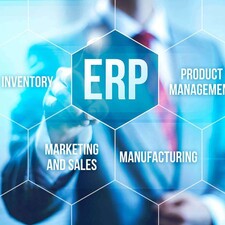Blog
ERP Advances Essential as Automotive Sector Faces Disruption

Summary
The automotive industry is going through a period of rapid and extremely disruptive change. And the shift isn't just economic or strategic – manufacturers are facing technological advances that are pushing them to adjust almost every component of their business. As a result, enterprise resource planning system modernization is becoming an essential need in the industry.
When it comes to establishing an ERP, automotive manufacturers need solutions that allow them to adapt and change easily, creating and automating workflows on an as-needed basis while integrating new technologies into operations. Legacy ERP solutions that have been highly customized for how your business used to run will generally lack the flexibility needed to keep up with today's demands, let alone be able to carry your business into the future.
Whether you have an ERP setup that's in need of replacement or have yet to put a solution in place, it's time to think seriously about how better data access and coordination across your business can support your operational goals.
Starting an ERP Selection Process? Get off on the right track - download our guide to the 7 Easy Steps of ERP Selection

The need for ERP advances in the automotive sector
The internet of things (IoT), robotics, digital service models and a variety of disruptions are coming together to drive rapid growth and put immense pressure to innovate on automotive manufacturers.
Persistence Market Research discovered that the global auto parts manufacturing industry is poised for considerable growth moving forward, with the sector set to achieve a value of more than $115 billion by the end of 2025. The study found that a variety of conditions are making this expansion possible, but much of it comes in delivering more advanced, sophisticated products to the marketplace. However, there are a variety of challenges ahead, including:
-
A growing need to manufacture brake pads while using fewer raw materials, particularly copper and heavy metals.
-
An increased demand for specialized products that incorporate sophisticated technologies.
-
A staggering need for both high-energy density batteries and lithium-ion batteries.
-
A general rise in demand for automotive production.

Industry 4.0 is heralded as a paradigm shift on par with the Industrial Revolution.
Taken together, these trends make up a situation in which manufacturers can expect disruption to everything from the supply chain to production and order fulfillment. Digitization is necessary in response, especially as change is only expected to continue moving forward.
Two systemic shifts are poised to transform the automotive sector moving forward. A Transport Intelligence study found that electric vehicles and self-driving capabilities are going to alter the status quo in the industry. Alternatives to the combustion engine are becoming viable in the sector, automated guidance systems are gaining momentum and aftermarket services are becoming more prominent.
the automotive sector is facing end-to-end change
The theme in this study is the same as before: The automotive sector is facing end-to-end change. The disruption is happening from the supply chain out to end-user services. Software updates for cars based on customer usage data are even becoming more common in the sector. Because of this, organizations must be able to gather relevant information from across their lines of business and bring that data to stakeholders in real time.
Considering the implications of automotive manufacturing disruption
The number and scale of changes happening for automotive companies can be staggering, and better data transparency plays a vital role in how manufacturers can respond to these shifts. Consider just how dramatic the changes could be: The Transport Intelligence study mentioned above said that, in the very near future, automotive supply chains and production lines will start to look more like the high-tech sector than how the automotive industry has operated in the past.
To consider the scope of disruption happening, consider the trend of manufacturing brake pads with reduced quantities of copper and heavy metals. In this scenario, organizations must:
-
Source copper and heavy metals more strategically to ensure they get sufficient quantities of the material but avoid waste through excess orders or getting supply from unnecessarily expensive sources.
-
Revise part plans to incorporate any design changes that may be needed to incorporate new materials.
-
Identify vendors that are best capable of keeping pace with production requirements in a fiscally healthy way.
-
Adjust inventory management procedures to optimize the amount of new supply being maintained at any given time relative to the shelf life and quantity requirements for goods.
-
Rebuild production workflows based around new designs that incorporate alternative materials.
-
Optimize and automate processes leveraging robotics solutions and IoT capabilities.
-
Track use patterns in the field. For example, you can do this by using sensors to identify wear and tear and automatically notify customers when maintenance or replacements are needed.
With disruption in just one part type, organizations are having to change their supply chain and warehouse procedures, adjust production and create new end-user services. The possibilities here are considerable. An organization could conceivably track all of its brake products in the field and identify when replacement parts will be needed based on real-time data pertaining to wear and tear. Then, custom orders and production runs can be made when demand arises, optimizing inventory levels to real-world demand with precision.
automotive manufacturers aren't just production companies, but are also becoming service providers
Now, it's quite possible that a strategy this robust won't make sense for every part or component of a vehicle, but it's already evident in how leading manufacturers are handling software services, product updates and similar advances in how they support customers after they have purchased a car. The result is an environment in which automotive manufacturers aren't just production companies, but are also service providers. Autonomous vehicles could take this to an entirely new level, as many experts believe self-driving cars will lead consumers toward shared automotive subscription services instead of owning a vehicle.
All of this change is beginning to happen now, and ERP solutions lay the groundwork businesses need to adjust and adapt over time. However, traditional ERP architectures aren't necessarily going to be up to the task. For many manufacturers, completely transforming into what the industry could look like in five or 10 years is unrealistic. Iterative, gradual growth will necessary. Organizations need ERP platforms that can meet current demands and grow as their needs change.
ERP software and the new automotive reality
With IoT-enabled technologies penetrating every phase of operations, automotive manufacturers have an opportunity to develop a stronger cohesiveness across all operations. Where in the past, organizations may have used annual sales projects to schedule production and orders, they can now dig into granular data to optimize part production based on detailed supply and demand information. Historically, suppliers and vendors represented a blind spot, sensors and monitoring devices can automatically update teams when a raw material shipment leaves a third-party facility or is stuck in transit.
Modern ERP solutions are necessary in gathering this information in a coherent way and delivering it to stakeholders in real time. A few ways ERP systems accomplish this are:
-
Supplier portals that serve as a central hub that allows manufacturers and vendors to communicate on projects and share updates to keep all stakeholders informed.
-
Financial modules that bring together invoices, purchase orders, bills, and similar details to allow for complete cost, income and revenue tracking. Furthermore, reporting tools make it easier to generate fiscal updates and alleviate the operational burden that comes with analyzing financial health.
-
Customer relationship management tools that are integrated into the rest of the ERP solution to create seamless user experiences and save employees from having to bounce between separate solutions to keep pace with operational demands created by emerging service models.
-
Lot tracking tools that integrate data from digital assets and IoT devices to provide seamless, real-time updates on assets and automatically track components through a wide range of processes, including ordering, production and recalls.
These capabilities add up to empower automotive manufacturers to respond to their immediate issues, but they also need ERP solutions that allow them to change and adapt over time.
Implementing an ERP setup that is ready for the future
If you've invested in an ERP solution only to have to customize it so extensively that you end up stuck with what you have or need to outright replace it, you know that many traditional platforms aren't built for change. They were designed to help you get it set up for your business and run everything smoothly. As demands change quickly in the automotive sector, organizations need solutions that can adapt and shift without significant overhead.
Cloud-based ERP platforms are invaluable here because they are often much easier to implement and manage on an ongoing basis. By housing the ERP in the cloud, companies can house modules in a central infrastructure setup where it is tightly integrated between various applications within the system. As such, your various modules are not only tightly linked from a data perspective, but also in terms of interface and accessibility. This means your users have easy access to the data they need without having to jump between disparate systems. Furthermore, a mobile-optimized ERP solution can offer equal functionality across device types.
You might also be interested in: our Guide to Writing a Better ERP RFP:

All of these capabilities come together to create flexibility that has long been impossible using traditional ERP software. Because legacy systems were traditionally built in a piecemeal way, with each module having different underlying programming defining how it functions, you can't really change or update one part of the system or one multifaceted process without having to adjust the underlying architecture.
The abas ERP solution for automotive makes deep customization unnecessary. We provide a two-tiered architecture in which the core of the database that governs data management and similar systems operates separately from the front-end interface and dashboards that users see. Because of this, you can adjust one area without having to change another. If you have a new process you want to build, but all of the data you'll need is already in the system, you can easily do so without having to create custom code to change backend data management.
With its unique underlying architecture, the abas ERP platform provides a robust base in which customization isn't necessary, but flexibility and adaptability are retained. With automotive manufacturers facing mounting challenges to constantly adapt in a changing market, they need an underlying ERP system foundation that can evolve with them. They can't afford to get locked into monolithic systems or outdated processes.
The abas ERP system provides the flexibility the automotive industry needs to keep pace with the rapid changes on the horizon. Our focus on adaptability can empower firms to stay ahead of the disruption on the horizon and integrate emerging technologies into operations without excessive overhead.
Gain a competitive advantage in the automotive industry today by downloading our free whitepaper: ERP Selection for Midmarket Automotive Companies. If you have any further questions please feel free to contact an abas representative today.


